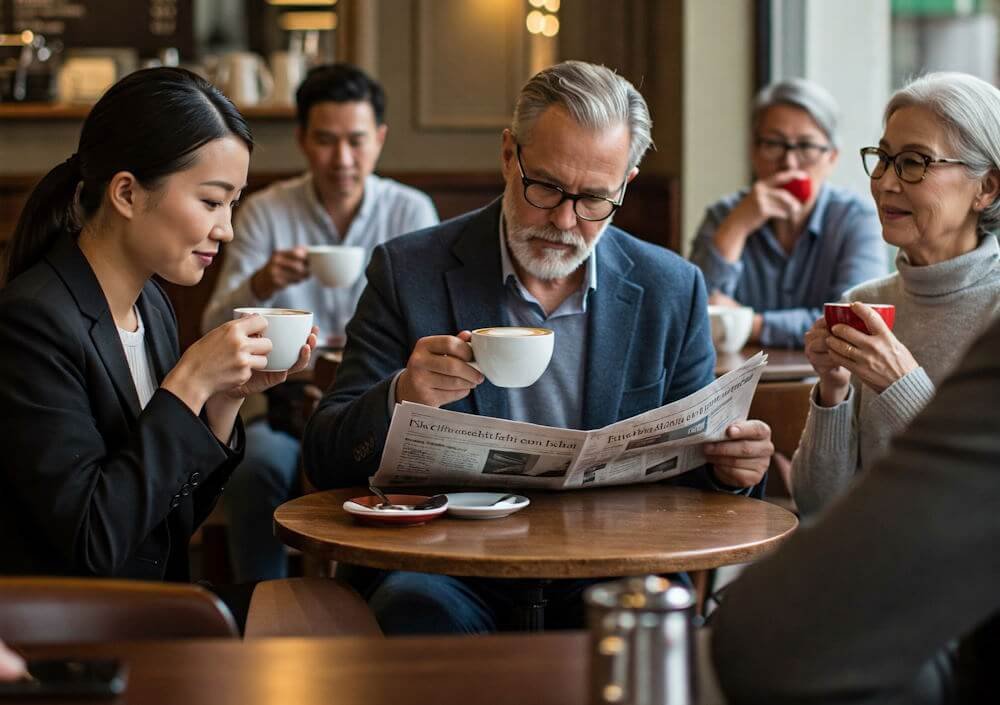Coffee culture encompasses the social, economic, and aesthetic practices associated with the consumption of coffee. This culture varies widely across different regions, reflecting diverse traditions, flavors, and customs. In many societies, coffee serves not only as a popular beverage but also as a pivotal social lubricant that fosters connections among people. Whether enjoyed in a bustling café or during intimate gatherings, coffee acts as a bridge that brings individuals together, enabling conversations that can range from casual chats to profound discussions.
In countries such as Italy, coffee is imbued with specific rituals; customers might stand at the bar for a quick espresso, while in contrast, Scandinavian countries celebrate leisurely coffee breaks known as “kaffepause.” These differences highlight how coffee transcends mere consumption, evolving into a vital aspect of social interaction in various cultures. Knowledge of local customs enhances the experience and fosters respectful engagement in coffee settings.
Understanding coffee etiquette becomes essential when navigating cafés across the globe. Different places may have unique norms regarding the ordering process, tipping practices, or even how to enjoy the drink itself. For instance, in some cultures, it is customary to order a coffee with certain parameters regarding strength or size, while others may place importance on having a friendly chat with the barista. By adhering to these cultural nuances, patrons can create a positive impression and contribute to a friendly atmosphere, thereby enriching their coffee experience.
Ultimately, becoming acquainted with coffee culture and its associated etiquette not only enhances one’s enjoyment of the beverage but also signifies respect for the traditions of others. Embracing these practices can lead to a profound appreciation of coffee’s role in daily life and its significance in uniting people worldwide.
Understanding the Menu: Coffee Types and Terms
When walking into a café, the menu can often resemble a labyrinth of options, especially for those unfamiliar with coffee nuances. Understanding the basic coffee types and terms is essential in making an informed choice that suits your palate. At the heart of many coffee beverages is espresso, a concentrated coffee brewed by forcing hot water through finely-ground coffee beans. Espresso serves as the foundation for various drinks, including lattes and cappuccinos.
A latte, for example, combines one shot of espresso with steamed milk and a small amount of milk foam on top, resulting in a creamy drink that is popular among coffee enthusiasts. On the other hand, a cappuccino consists of equal parts espresso, steamed milk, and milk foam, offering a bolder flavor profile due to the reduced milk content. Understanding these basic constructs provides clarity in selecting your preferred beverage.
Another essential term is ‘macchiato,’ which means ‘stained’ or ‘spotted’ in Italian. This drink typically consists of espresso ‘stained’ with a small amount of foamed milk, creating a strong coffee experience with a subtle creamy texture. For those who enjoy a silky smooth drink, a ‘flat white’ has gained popularity. This beverage features espresso combined with microfoam, creating a velvety texture without the layers typical of lattes and cappuccinos.
As you navigate a café menu, familiarity with these terms can boost your confidence in ordering. Additionally, many cafés are starting to offer cold brew and nitro coffee, which are brewed differently and often served over ice or infused with nitrogen for a creamy finish, respectively. By understanding these coffee types and their distinctions, you will not only enhance your café experience but also cultivate your coffee appreciation journey.
Ordering Procedures: How to Place Your Order
When visiting a café, understanding the standard procedures for placing an order can significantly enhance your experience. Upon entering the establishment, it is advisable to first observe the environment and familiarize yourself with the menu offerings. This will not only help you make a more informed decision but will also show respect for the staff and other customers by minimizing wait times.
Approaching the counter should be done with courtesy. Wait patiently in line, and when it’s your turn, step forward confidently. It is important to maintain a polite demeanor and make eye contact with the barista while you prepare to place your order. A warm greeting such as “Hello” or “Good morning” can set a positive tone for the interaction. Clearly stating your order is crucial in this process; avoid using vague terms, and instead, specify the exact drink you desire. For example, if you want a cappuccino, mention any preferences regarding size, type of milk, or sweetness level to convey your order accurately.
Familiarizing yourself with café lingo can also enhance your ordering experience. If applicable, use phrases such as “I’m looking for a bold roast” or “Could I have that iced, please?” which help clarify your preferences. If you are uncertain about certain terms or offerings, do not hesitate to ask the barista for recommendations. Customer service is typically a priority for café staff, and they are often more than willing to assist you in making a choice.
Lastly, it’s courteous to thank the barista after placing your order. A simple “Thank you” conveys appreciation for their assistance. Following these ordering protocols will help instill a sense of professionalism while enhancing your overall café experience.
Mind Your Manners: Café Etiquette and Behavior
When visiting a café, understanding and practicing proper etiquette is vital to ensuring a pleasant experience for both patrons and staff. To begin with, politeness should be the cornerstone of your interactions. Greeting the staff with a friendly “hello” or “please” when placing your order not only reflects good manners but also fosters a welcoming atmosphere. Remember, baristas are there to help, and treating them with respect can often result in better service.
Queue etiquette is another essential aspect of café manners. Observing the order of arrival is crucial; cutting in line can create tension and disrupt the flow of service. If the café is busy, be prepared to wait patiently until it is your turn. Engaging in light conversation or simply enjoying the ambiance can be a productive way to occupy your time while respecting others who are also waiting to place their orders.
Maintaining an appropriate noise level is also key to a pleasant experience in a café setting. While many individuals visit cafés to socialize, it is important to be mindful of your volume. Excessive noise can disturb other customers. If you are part of a larger group, consider keeping discussions at a moderate volume and being aware of your surroundings. If you find yourself in a quiet atmosphere, it may be wise to lower your voice further to ensure everyone can enjoy their visit.
Lastly, being discreet about phone conversations can enhance the experience for everyone. If you must take a call, stepping outside is advisable. This simple act of consideration shows respect to both staff and fellow patrons, making the café environment more enjoyable overall.
This or That: Choosing Between Dine-in and Takeaway
When visiting a café, one of the primary decisions patrons face is whether to dine-in or opt for takeaway. Each choice comes with its own set of etiquette and expectations. Dine-in customers typically enjoy a leisurely experience, allowing them to savor their coffee in a comfortable environment. When choosing to settle in, it is essential to be mindful of the café’s atmosphere and the flow of service. For instance, patrons should keep conversations at a reasonable volume to create a pleasant ambiance for others, ensuring that the space remains conducive for all visitors.
When dining in, customers should be prepared for table service or, in some cases, a counter ordering system. It is customary to approach the counter to place an order, after which patrons often receive a number or a name tag to collect their drinks. Once seated, patrons should refrain from lingering excessively if they do not plan on ordering additional items, as this can impede the café’s ability to accommodate new customers. Additionally, taking care to clear the table after finishing one’s coffee can be seen as a courteous gesture towards the staff.
In contrast, opting for takeaway brings its own considerations. Customers tend to expect a quicker service, as many are on the go. This scenario usually involves ordering directly at the counter with little time for an expansive conversation. It is considered polite to maintain efficiency during the ordering process. Furthermore, patrons can expect their beverages to be prepared for immediate consumption, so being ready with your choice is essential. Acknowledging the barista’s service with a simple thank you can enhance the takeaway experience, promoting positive interactions even in brief encounters.
Ultimately, whether one chooses to dine in or take away, understanding these nuances enhances the overall café experience. Each choice comes with its own set of behaviors that reflect courtesy, respect, and appreciation towards the café staff and fellow patrons.
Customizing Your Order: Do’s and Don’ts
When it comes to ordering coffee at a café, customization can be a delightful opportunity to create a beverage that suits your taste. However, navigating the customization process requires mindfulness and respect for the baristas’ expertise. Understanding the do’s and don’ts of coffee order modifications can enhance your café experience while fostering a positive interaction with the staff.
Do approach customization with clarity. When placing your order, articulate your modifications succinctly. For example, instead of asking for a “tall latte with less foam and almond milk,” a clearer request would be “a tall latte with almond milk and minimal foam.” This not only aids the barista in executing your order efficiently but also demonstrates that you appreciate their time and skills. Additionally, it is prudent to familiarize yourself with the café’s menu and options, as baristas are often well-versed in the offerings and can suggest popular combinations that you may not have considered.
Don’t overwhelm your order with excessive changes. While many coffee enthusiasts enjoy the flexibility of customizing their drinks, it is essential to recognize that some adjustments may complicate preparation. Requests like “I want half-caf, extra hot, with two pumps of vanilla and a sprinkle of cinnamon” can be challenging for baristas to fulfill accurately. It is advisable to limit your modifications to a few key preferences to maintain the integrity of the original beverage.
Moreover, it is important to be respectful of the café’s guidelines and the barista’s expertise. If a particular modification cannot be fulfilled due to the café’s policies, maintain a gracious attitude. A courteous interaction not only leads to a better coffee experience but also builds rapport with the staff, ensuring they are more inclined to accommodate your future orders. Ultimately, thoughtful and respectful customization can enhance your café outing significantly.
Tipping Practices in Coffee Shops
Tipping is an integral part of the coffee culture in various regions, reflecting both appreciation for service and the overall quality of the café experience. While tipping norms can differ significantly from one locale to another, understanding these practices is essential for anyone wishing to navigate the café landscape respectfully. In many places, a standard tip for baristas varies between 15% to 20% of the total bill, which is comparable to the tipping customs found in restaurants. However, in cafés that offer a more casual, fast-service model, a smaller percentage may be more appropriate.
The amount you choose to tip can also depend on the service you receive. For excellent service—perhaps characterized by friendly conversation, recommendations, or customized drinks—a tip at the higher end of the scale is encouraged. On the other hand, if the service is minimal or lacking, a lower percentage may be justified. Regional differences in tipping practices are noteworthy as well. For instance, in cities like New York or San Francisco, patrons often adhere closely to the 15%-20% guideline, while in smaller towns or rural areas, tipping might be less common or considered optional. Additionally, some coffee shops have adopted innovative tipping technologies, allowing customers to conveniently add tips through payment systems. In these environments, patrons can select from preset tipping options, typically ranging from small to generous amounts, which aids in the decision-making process.
Regardless of the specific percentage or regional norms, tipping remains an important expression of gratitude within coffee culture. It acknowledges the labor and skill of baristas who prepare each beverage with care and precision. Consistent tipping not only supports the livelihoods of these workers but also encourages a welcoming atmosphere in cafés, ultimately enriching the overall coffee experience.
Conclusion: Making the Most of Your Café Experience
Enhancing your café experience goes beyond simply placing an order; it involves immersing yourself in the atmosphere, engaging with the staff, and being open to exploring various coffee varieties. To make the most of your time at a café, consider arriving during less busy hours, allowing you to appreciate the ambiance without the rush. Take a moment to observe the décor, the layout, and the overall vibe of the café, as these elements contribute significantly to your experience.
Engaging in conversation with the baristas can also enrich your visit. They are often passionate about coffee and can share knowledge and recommendations that may introduce you to new flavors and brewing techniques. Inquire about the coffee origin, the roasting methods, or any seasonal specialties they might have. This not only enhances your understanding of coffee but also builds a rapport with the staff, making your visit more enjoyable.
Furthermore, consider broadening your coffee palate by trying different varieties. Most cafés offer a range of options, from espresso to pour-over, and even specialty drinks. Experimenting with different brewing methods, such as cold brew or nitro coffee, can help you discover what you truly enjoy. Don’t hesitate to ask for suggestions or to request a taste test before making a decision. This willingness to explore can transform a typical café visit into a delightful journey through the world of coffee.
Ultimately, your café experience should be a reflection of enjoyment and exploration. By engaging with your surroundings, conversing with staff, and trying new offerings, you can cultivate a deeper appreciation for the art of coffee while making the most of your time at any café.
Additional Resources: Learning More About Coffee
For those wishing to expand their understanding of coffee beyond the immediate experience of ordering at a café, a wealth of resources are available. Books, websites, and even local courses can enhance your appreciation of this intricate beverage, fostering a deeper connection to its history, culture, and nuances.
One highly recommended book is “The World Atlas of Coffee” by James Hoffmann. This comprehensive guide provides insights into various coffee-growing regions, brewing methods, and tasting notes. It is an invaluable resource for both novices and seasoned coffee enthusiasts. Another excellent title is “Coffee: A Global History” by Jonathan Morris, which explores the social, cultural, and economic aspects of coffee throughout history. These books can serve as a fantastic starting point for readers looking to deepen their expertise.
In addition to literature, numerous websites act as enriching platforms for coffee lovers. Websites such as the Specialty Coffee Association (SCA) and Barista Hustle offer articles, tutorials, and resources that celebrate coffee culture. They provide insights into coffee brewing techniques, equipment reviews, and industry news, emphasizing the importance of quality and sustainability in coffee production.
For individuals interested in hands-on learning, consider enrolling in local coffee courses. Many roasteries and cafés have training programs that cover brewing techniques, espresso preparation, and latte art. These classes not only improve practical skills but also allow enthusiasts to make connections with like-minded individuals in the coffee community.
In summation, by engaging with these resources and activities, coffee fans can elevate their appreciation of this beloved beverage. Whether through reading, online exploration, or practical experiences, the journey of learning more about coffee is both enjoyable and rewarding.





